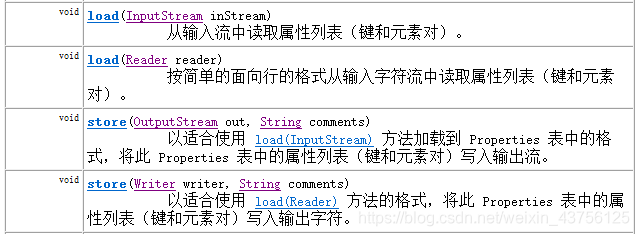一、 Properties类
1. Properties类介绍
Properties 类表示了一个持久的属性集。Properties 可保存在流中或从流中加载。属性列表中每个键及其对应值都是一个字符串。
特点:
1、Hashtable的子类,map集合中的方法都可以用。
2、该集合没有泛型。键值都是字符串。
3、它是一个可以持久化的属性集。键值可以存储到集合中,也可以存储到持久化的设备(硬盘、U盘、光盘)上。键值的来源也可以是持久化的设备。
4、有和流技术相结合的方法。

load(InputStream) 把指定流所对应的文件中的数据,读取出来,保存到Propertie集合中
load(Reader)
store(OutputStream,commonts)把集合中的数据,保存到指定的流所对应的文件中,参数commonts代表对描述信息
stroe(Writer,comments);
代码演示:
/*
*
* Properties集合,它是唯一一个能与IO流交互的集合
*
* 需求:向Properties集合中添加元素,并遍历
*
* 方法:
* public Object setProperty(String key, String value)调用 Hashtable 的方法 put。
* public Set<String> stringPropertyNames()返回此属性列表中的键集,
* public String getProperty(String key)用指定的键在此属性列表中搜索属性
*/
public class PropertiesDemo01 {
public static void main(String[] args) {
//创建集合对象
Properties prop = new Properties();
//添加元素到集合
//prop.put(key, value);
prop.setProperty("周迅", "张学友");
prop.setProperty("李小璐", "贾乃亮");
prop.setProperty("杨幂", "刘恺威");
//System.out.println(prop);//测试的使用
//遍历集合
Set<String> keys = prop.stringPropertyNames();
for (String key : keys) {
//通过键 找值
//prop.get(key)
String value = prop.getProperty(key);
System.out.println(key+"==" +value);
}
}
}
- 将集合中内容存储到文件
需求:使用Properties集合,完成把集合内容存储到IO流所对应文件中的操作
分析:
1,创建Properties集合
2,添加元素到集合
3,创建流
4,把集合中的数据存储到流所对应的文件中
stroe(Writer,comments)
store(OutputStream,commonts)
把集合中的数据,保存到指定的流所对应的文件中,参数commonts代表对描述信息
5,关闭流
代码演示:
public class PropertiesDemo02 {
public static void main(String[] args) throws IOException {
//1,创建Properties集合
Properties prop = new Properties();
//2,添加元素到集合
prop.setProperty("周迅", "张学友");
prop.setProperty("李小璐", "贾乃亮");
prop.setProperty("杨幂", "刘恺威");
//3,创建流
FileWriter out = new FileWriter("prop.properties");
//4,把集合中的数据存储到流所对应的文件中
prop.store(out, "save data");
//5,关闭流
out.close();
}
}
- 读取文件中的数据,并保存到集合
需求:从属性集文件prop.properties 中取出数据,保存到集合中
分析:
1,创建集合
2,创建流对象
3,把流所对应文件中的数据 读取到集合中
load(InputStream) 把指定流所对应的文件中的数据,读取出来,保存到Propertie集合中
load(Reader)
4,关闭流
5,显示集合中的数据
代码演示:
public class PropertiesDemo03 {
public static void main(String[] args) throws IOException {
//1,创建集合
Properties prop = new Properties();
//2,创建流对象
FileInputStream in = new FileInputStream("prop.properties");
//FileReader in = new FileReader("prop.properties");
//3,把流所对应文件中的数据 读取到集合中
prop.load(in);
//4,关闭流
in.close();
//5,显示集合中的数据
System.out.println(prop);
}
}
注意:使用字符流FileReader就可以完成文件中的中文读取操作了
二、 序列化流与反序列化流
用于从流中读取对象的操作流 ObjectInputStream 称为 反序列化流
用于向流中写入对象的操作流 ObjectOutputStream 称为 序列化流
l 特点:用于操作对象。可以将对象写入到文件中,也可以从文件中读取对象。
1. 对象序列化流ObjectOutputStream
ObjectOutputStream 将 Java 对象的基本数据类型和图形写入 OutputStream。可以使用 ObjectInputStream 读取(重构)对象。通过在流中使用文件可以实现对象的持久存储。
注意:只能将支持 java.io.Serializable 接口的对象写入流中


l 代码演示:
public class ObjectStreamDemo {
public static void main(String[] args) throws IOException, ClassNotFoundException {
/*
* 将一个对象存储到持久化(硬盘)的设备上。
*/
writeObj();//对象的序列化。
}
public static void writeObj() throws IOException {
//1,明确存储对象的文件。
FileOutputStream fos = new FileOutputStream("tempfile\\obj.object");
//2,给操作文件对象加入写入对象功能。
ObjectOutputStream oos = new ObjectOutputStream(fos);
//3,调用了写入对象的方法。
oos.writeObject(new Person("wangcai",20));
//关闭资源。
oos.close();
}
}
l Person类
public class Person implements Serializable {
private String name;
private int age;
public Person() {
super();
}
public Person(String name, int age) {
super();
this.name = name;
this.age = age;
}
public String getName() {
return name;
}
public void setName(String name) {
this.name = name;
}
public int getAge() {
return age;
}
public void setAge(int age) {
this.age = age;
}
@Override
public String toString() {
return "Person [name=" + name + ", age=" + age + "]";
}
}
2. 对象反序列化流ObjectInputStream
ObjectInputStream 对以前使用 ObjectOutputStream 写入的基本数据和对象进行反序列化。支持 java.io.Serializable接口的对象才能从流读取。


l 代码演示
public class ObjectStreamDemo {
public static void main(String[] args) throws IOException, ClassNotFoundException {
readObj();//对象的反序列化。
}
public static void readObj() throws IOException, ClassNotFoundException {
//1,定义流对象关联存储了对象文件。
FileInputStream fis = new FileInputStream("tempfile\\obj.object");
//2,建立用于读取对象的功能对象。
ObjectInputStream ois = new ObjectInputStream(fis);
Person obj = (Person)ois.readObject();
System.out.println(obj.toString());
}
}
3. 序列化接口
当一个对象要能被序列化,这个对象所属的类必须实现Serializable接口。否则会发生异常NotSerializableException异常。
同时当反序列化对象时,如果对象所属的class文件在序列化之后进行的修改,那么进行反序列化也会发生异常InvalidClassException。发生这个异常的原因如下:
l 该类的序列版本号与从流中读取的类描述符的版本号不匹配
l 该类包含未知数据类型
l 该类没有可访问的无参数构造方法
Serializable标记接口。该接口给需要序列化的类,提供了一个序列版本号。serialVersionUID. 该版本号的目的在于验证序列化的对象和对应类是否版本匹配。
l 代码修改如下,修改后再次写入对象,读取对象测试
public class Person implements Serializable {
//给类显示声明一个序列版本号。
private static final long serialVersionUID = 1L;
private String name;
private int age;
public Person() {
super();
}
public Person(String name, int age) {
super();
this.name = name;
this.age = age;
}
public String getName() {
return name;
}
public void setName(String name) {
this.name = name;
}
public int getAge() {
return age;
}
public void setAge(int age) {
this.age = age;
}
@Override
public String toString() {
return "Person [name=" + name + ", age=" + age + "]";
}
}
4. 瞬态关键字transient
当一个类的对象需要被序列化时,某些属性不需要被序列化,这时不需要序列化的属性可以使用关键字transient修饰。只要被transient修饰了,序列化时这个属性就不会被序列化了。
同时静态修饰也不会被序列化,因为序列化是把对象数据进行持久化存储,而静态的属于类加载时的数据,不会被序列化。
l 代码修改如下,修改后再次写入对象,读取对象测试
public class Person implements Serializable {
/*
* 给类显示声明一个序列版本号。
*/
private static final long serialVersionUID = 1L;
private static String name;
private transient/*瞬态*/ int age;
public Person() {
super();
}
public Person(String name, int age) {
super();
this.name = name;
this.age = age;
}
public String getName() {
return name;
}
public void setName(String name) {
this.name = name;
}
public int getAge() {
return age;
}
public void setAge(int age) {
this.age = age;
}
@Override
public String toString() {
return "Person [name=" + name + ", age=" + age + "]";
}
}
三、 打印流
1. 打印流的概述
打印流添加输出数据的功能,使它们能够方便地打印各种数据值表示形式.
打印流根据流的分类:
l 字节打印流 PrintStream
l 字符打印流 PrintWriter
l 方法:
void print(String str): 输出任意类型的数据,
void println(String str): 输出任意类型的数据,自动写入换行操作
l 代码演示:
/*
* 需求:把指定的数据,写入到printFile.txt文件中
*
* 分析:
* 1,创建流
* 2,写数据
* 3,关闭流
*/
public class PrintWriterDemo {
public static void main(String[] args) throws IOException {
//创建流
//PrintWriter out = new PrintWriter(new FileWriter("printFile.txt"));
PrintWriter out = new PrintWriter("printFile.txt");
//2,写数据
for (int i=0; i<5; i++) {
out.println("helloWorld");
}
//3,关闭流
out.close();
}
}
2. 打印流完成数据自动刷新
可以通过构造方法,完成文件数据的自动刷新功能
l 构造方法:
l 开启文件自动刷新写入功能
public PrintWriter(OutputStream out, boolean autoFlush)
public PrintWriter(Writer out, boolean autoFlush)
l 代码演示:
/*
* 分析:
* 1,创建流
* 2,写数据
*/
public class PrintWriterDemo2 {
public static void main(String[] args) throws IOException {
//创建流
PrintWriter out = new PrintWriter(new FileWriter("printFile.txt"), true);
//2,写数据
for (int i=0; i<5; i++) {
out.println("helloWorld");
}
//3,关闭流
out.close();
}
}
四、 commons-IO
1. 导入classpath
加入classpath的第三方jar包内的class文件才能在项目中使用
创建lib文件夹
将commons-io.jar拷贝到lib文件夹
右键点击commons-io.jar,Build Path→Add to Build Path
2. FilenameUtils
这个工具类是用来处理文件名(译者注:包含文件路径)的,他可以轻松解决不同操作系统文件名称规范不同的问题
l 常用方法:
getExtension(String path):获取文件的扩展名;
getName():获取文件名;
isExtension(String fileName,String ext):判断fileName是否是ext后缀名;
- FileUtils
提供文件操作(移动文件,读取文件,检查文件是否存在等等)的方法。
l 常用方法:
readFileToString(File file):读取文件内容,并返回一个String;
writeStringToFile(File file,String content):将内容content写入到file中;
copyDirectoryToDirectory(File srcDir,File destDir);文件夹复制
copyFile(File srcFile,File destFile);文件夹复制
l 代码演示:
/*
* 完成文件的复制
*/
public class CommonsIODemo01 {
public static void main(String[] args) throws IOException {
//method1("D:\\test.avi", "D:\\copy.avi");
//通过Commons-IO完成了文件复制的功能
FileUtils.copyFile(new File("D:\\test.avi"), new File("D:\\copy.avi"));
}
//文件的复制
private static void method1(String src, String dest) throws IOException {
//1,指定数据源
BufferedInputStream in = new BufferedInputStream(new FileInputStream(src));
//2,指定目的地
BufferedOutputStream out = new BufferedOutputStream(new FileOutputStream(dest));
//3,读
byte[] buffer = new byte[1024];
int len = -1;
while ( (len = in.read(buffer)) != -1) {
//4,写
out.write(buffer, 0, len);
}
//5,关闭流
in.close();
out.close();
}
}
/*
* 完成文件、文件夹的复制
*/
public class CommonsIODemo02 {
public static void main(String[] args) throws IOException {
//通过Commons-IO完成了文件复制的功能
FileUtils.copyFile(new File("D:\\test.avi"), new File("D:\\copy.avi"));
//通过Commons-IO完成了文件夹复制的功能
//D:\基础班 复制到 C:\\abc文件夹下
FileUtils.copyDirectoryToDirectory(new File("D:\\基础班"), new File("C:\\abc"));
}
}
























 109
109

 被折叠的 条评论
为什么被折叠?
被折叠的 条评论
为什么被折叠?








